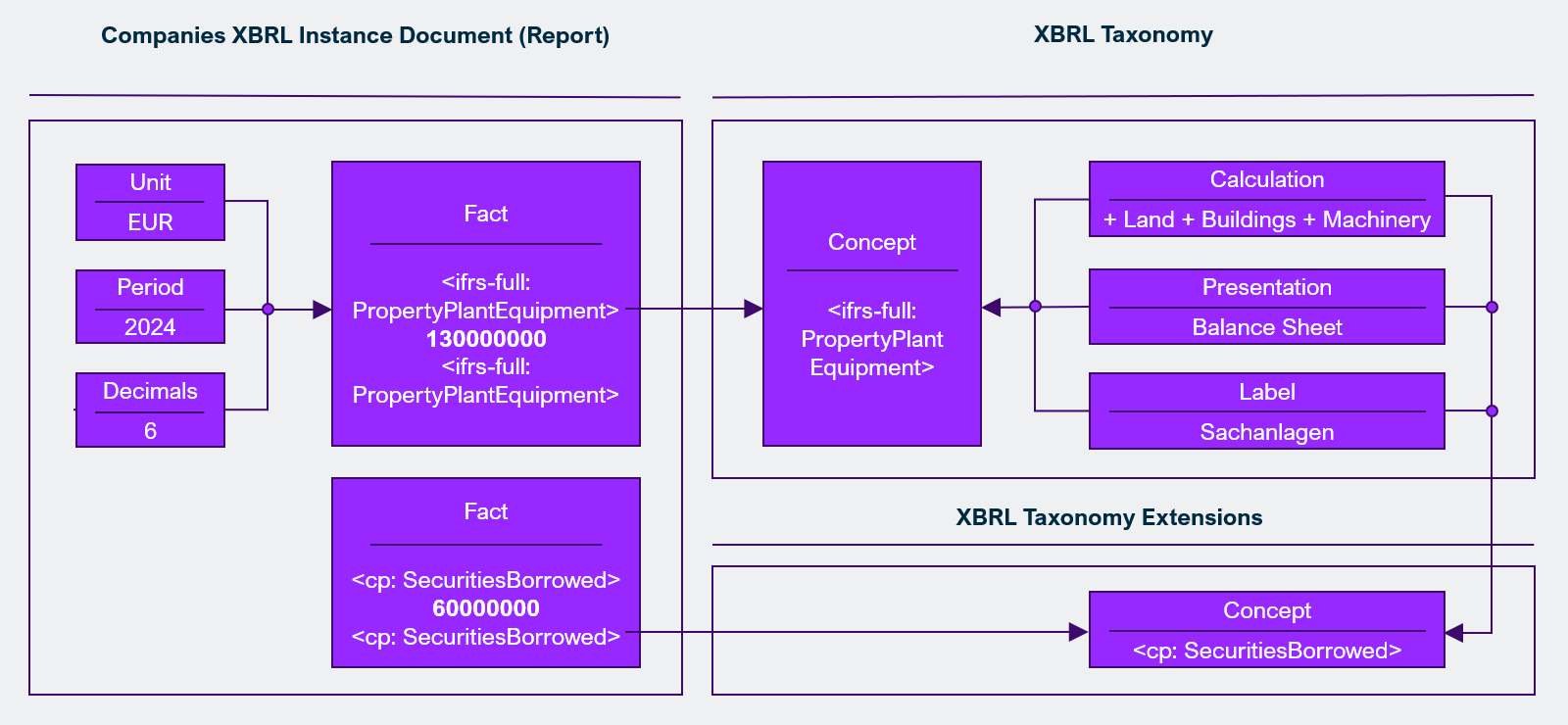Introduction to iXBRL and the XBRL Tagger
Last updated on 2025-08-29
Overview
The reports created by the Lucanet XBRL Tagger are based on the standard iXBRL. You can find the corresponding basic information in this chapter.
This article contains the following sections:
Definition
iXBRL (Inline eXtensible Business Reporting Language) is a standard derived from the standard XBRL. XBRL allows financial data to be displayed in a format that can be read by human beings and machines. This dual function increases the transparency and user friendliness of financial reports and ensures that they are easy to access and analyze by a wide range of stakeholders, including supervisory authorities, investors, and analysts.
Reports and Taxonomies
The ESEF taxonomy is based on the IFRS taxonomy. In the figure above, the XBRL report on the left side refers to the taxonomy items for every tagged number. As a result, additional information from the taxonomy is available for this concept, such as the label and the calculations to which this concept belongs.
A taxonomy extension must be created for company-specific items.
The format referred to as inline XBRL (also iXBRL) is XBRL embedded in HTML. The advantage of this format is that an iXBRL report can be opened in any web browser to be read by a human.
Further information
- You can find additional supplementary and detailed information on taxonomies and reports under Further Guidance - XBRL (English) and the underlying topics, including in:
- You can find numerous definitions and explanations for concepts and terms concerning (i)XBRL in the (external) XBRL Glossary.
Properties of the XBRL Tagger
Loading the XBRL Taxonomy
The XBRL Tagger makes the selection of taxonomies particularly easy, as these are already set up in pre-configured Reporting requirements. The taxonomies are typically represented using the Presentation, Calculation and Definition Linkbase. Translations of taxonomy elements in the form of labels are displayed in all languages that are supplied with the taxonomy.
Tagging Word Files with XBRL Taxonomy Elements
Word documents can be opened, analyzed, and displayed in the XBRL Tagger. The tagging itself is performed by drag & drop. The XBRL Tagger supports the user with consistency checks. Tables with multiple columns can be assigned using dimension elements from the taxonomy. All metadata required, such as the reporting period and currency, are automatically identified if possible. A status-based workflow can be implemented by using different colors for the tagging elements. The mapping itself can be exported and imported – The XBRL Tagger restores the tags even if numbers and texts are changed.
Taxonomy Extensions
The Tagger has a function for taxonomy extensions, which can be used to add elements that cannot be represented by the taxonomy. This function includes an anchoring function described by the ESMA (European Securities and Market Authority).
XHTML Converter and iXBRL Generation
The XBRL Tagger converts Word documents into valid XHTML, which is required for inline XBRL (iXBRL). The formatting and layout of the original documents are maintained as far as possible. An iXBRL report is saved after applying the XBRL tags according to the assignment.
Validations
When creating an iXBRL report, a complete XBRL validation is conducted, covering the following specifications:
- XBRL Specification 2.1
- XBRL Dimensions 1.0
- XBRL Formula 1.0
- Table Linkbase 1.0
- Extensible Enumerations 1.0 and 2.0
- Inline XBRL 1.1 incl. XHTML and Transformation Registries 1-4
- Unit Registry
- Additionally, a so-called filing rule validation is performed. For example, an ESEF report is checked against the ESEF Reporting Manual and the rules it contains.
